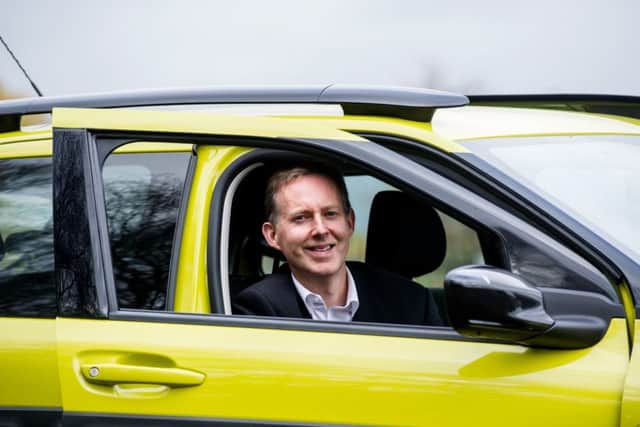Three-point turns out, satnavs in for new driving test
and live on Freeview channel 276
Learner drivers face the added challenge of using satnavs and negotiating more rural roads from next month in the biggest shake-up of the driving test for 20 years.
Traditional manoeuvres such as three-point turns and reversing round corners will be ditched to provide extra time for “more realistic” driving scenarios.
Advertisement
Hide AdAdvertisement
Hide AdThey will be replaced by a greater focus on country roads, which have the highest casualty rate.


Such roads accounted for 77 per cent of the 191 deaths on Scotland’s roads last year.
The new test also includes satnavs for the first time to demonstrate that novice motorists have learned to drive safely with such distractions.
The Driver and Vehicle Standards Agency (DVSA) said the new test was neither harder nor easier than its predecessor, and the 47 per cent pass rate was not expected to change.
Advertisement
Hide AdAdvertisement
Hide AdThe on-the-road part of the test will remain 30 minutes long, but the independent driving section – with no turn-by-turn instructions from the examiner – will double from ten to 20 minutes.


This will involve candidates following a pre-set route on a DVSA satnav which the examiner will place on the car’s dashboard.
New manoeuvres have also been added such as driving into and reversing out of a parking space.
Candidates will also be asked a safety question while driving, like how to use their windscreen washer or heated rear window.
Advertisement
Hide AdAdvertisement
Hide AdAll learners taking their test will follow the new format from Monday, 4 December in the biggest change since separate theory tests were introduced in 1996.
It follows a ten-month trial, which ended in January, involving learners volunteering to take the new test at 32 centres, including nearly 300 at Bishopbriggs in East Dunbartonshire and Musselburgh in East Lothian.
Although learners will be allowed on motorways from next year, there are no plans to add these to the driving test because they are the safest roads.
Lesley Young, the DVSA’s chief driving examiner, said the most crucial change in the new test was increased driving on country roads.
Advertisement
Hide AdAdvertisement
Hide AdShe said this was possible by saving the time used for the old-style manoeuvres on quiet urban streets.
Young told Scotland on Sunday: “The new test is more reflective of real-life driving, which was a criticism made in the past.
“The most significant element is the focus on a type of road that is high risk.
“There are fewer road signs and markings to help you on rural roads, and you come across things very quickly, such as horses and cyclists.
Advertisement
Hide AdAdvertisement
Hide Ad“It is far better we focus on that than slow manoeuvres in housing estates.”
Young rejected calls for restrictions on newly-qualified drivers, such as not carrying passengers.
She said: “We want to ensure drivers have the necessary skills before they pass their test, and not restrict them post-test.”
Driving instructors said they had been impatient for the new test. Peter Harvey, chairman of the Motor Schools Association of Great Britain, who teaches in Paisley, said: “The changes are well overdue – there is a need to do something to cut down the number of road deaths.
Advertisement
Hide AdAdvertisement
Hide Ad“More time in the test will be spent on country roads where more of the deaths happen.
“People are finding the new manoeuvres a bit more challenging, but it is the driving they do once they have passed their test.”
Neil Greig, policy and research director of motoring group IAM RoadSmart, said: “Driving on higher-speed roads is now possible with the extra time allocated for independent driving.
“Since these are the roads where new drivers are most at risk, this has to be a welcome improvement.”
CASE STUDY
Advertisement
Hide AdAdvertisement
Hide AdAs soon as the unfamiliar voice started issuing directions from the satnav, I knew this would be a very different driving test to the one I sat 30 years ago.
It started normally enough, with my examiner – DVSA head of driver training Gordon Witherspoon – instructing me to do a circuit of the driving test centre in Bishopbriggs – which is disconcertingly beside Low Moss prison.
However, as we approached the main road, the satnav piped up – and I found myself instead taking commands from a disembodied voice.
Trying to focus on my speed and other vehicles, and also keep checking my mirrors for good measure, I decided to concentrate on following the voice commands rather than looking at the screen too.
Advertisement
Hide AdAdvertisement
Hide AdMy next concern was making the correct turns, but I was relieved to hear that taking a wrong one is not an error if it’s done safely.
I immediately saw the relevance of another new part of the test – driving into and reversing out of a parking space. I’m still rubbish at it, but just about parked within the lines in the supermarket car park the satnav chose.
Did I pass? Thankfully, yes, with only one fault – cutting across a roundabout, which in my nervousness I hadn’t even noticed doing.